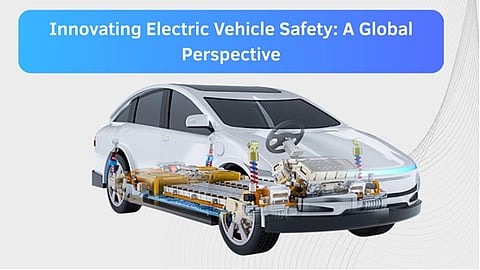

Electric vehicles (EVs) are poised to be the next transformative wave to take over the global automotive landscape, with 2023 serving as a critical inflection point on their journey to mass adoption. As EVs continue to gain traction — now with 14 million units sold worldwide even in the middle of a chip shortage — they’re predicted to make up 44% of the market share by 2030. In this era of expansion, there has been increased focus on their safety features, which have technically advanced dramatically to make them more reliable and ensure passenger safety. Mayank Rai, in his comprehensive safety analysis, delves into the advancements in EV safety technologies, examining structural integrity, battery protection, and driver assistance systems that are reshaping vehicle safety standards.
The transition from internal combustion engine (ICE) vehicles to electric vehicles (EVs) creates a different set of safety challenges and opportunities. Inherently safer, EVs have a simpler powertrain, which allows for larger crumple zones, and the high-voltage battery on the floor of the vehicle improves stability by lowering the center of gravity. This creates more vehicle stability and decreased risk of rollover and enhances the crash resistance of EVs. While safer in some respects, EVs require specialized safety systems due to their unique components.
Battery protection tends to be the most prominent feature of EV safety, given that the battery itself is widely considered the critical and most vulnerable EV component. With the help of advanced battery management systems (BMS) that monitor temperature, voltage, and overall battery health, these systems can give early warning signs to keep dangerous occurrences at bay. Furthermore, high-voltage disconnects in the event of a crash lower the risk of electrical fire. This multi-layered approach ensures enhanced safety for passengers, highlighting significant advancements in electric vehicle safety.
EVs embrace a suite of structural innovations that improve safety, including the creation of additional crumple zones because the EVs lack a conventional engine block to absorb the energy of an impact. Beverage container incidental travel continues to roll over in a vast majority of cases simply because the similar low centre of gravity that increases their rollover risks on all-terrain created reinforced passenger compartments that increase crash protection. Advanced safety systems and top-tier crash test ratings confirm that EVs provide excellent occupant protection during collisions.
Electric vehicles (EVs) With the rollout of EVs comes an increase in vehicle safety, as many EVs are equipped with advanced driver assistance systems (ADASs). Functions such as collision avoidance, adaptive cruise control, lane keeping assist and emergency braking provide an increased level of driver protection. By constantly monitoring the driver’s surroundings and using warning and intervention systems features, which help alert a driver to potential hazards, ADAS helps mitigate accident risks. The integration of regenerative and traditional braking systems in EVs further improves stopping power, especially in emergencies.
Thermal management in extreme climates is a key challenge for EVs. Advanced battery thermal management systems carefully regulate battery temperatures during operation to maintain performance, safety, and longevity. In extreme weather, they protect against overheating in high temperatures, and at the opposite end of the thermometer, they ensure operating temperatures stay safely above freezing. These systems help protect batteries not only to maximize their useful life, but to minimize the occurrence of thermal events such as fires or explosions. Ongoing advancements in thermal management are essential for improving EV safety and performance, making them more reliable under various environmental conditions.
As the electric vehicle market continues to expand, educating consumers is key to helping all operators of electric vehicles use them safely and properly. Knowing how to charge EVs safely, employing certified charging equipment, and practicing charging equipment routine maintenance and upkeep can go a long way toward realizing the safety benefits of EVs to the fullest. Furthermore, emergency response procedures should be uniform across manufacturers to allow for the same guidance to be provided in an accident regardless of the vehicle involved. The clear marking of high-voltage components and the implementation of robust thermal management systems are essential to preventing accidents, particularly during charging.
Looking ahead As NHTSA acknowledges, the need to improve EV safety will only grow stronger. Innovations in battery technology, including the creation of solid-state batteries, promise to make the beneficial impacts of improved EV safety even greater. These batteries hold a potential for higher energy densities, thus decreasing tendencies for thermal runaway and fires. Additionally, research into advanced materials for battery enclosures capable of withstanding extreme conditions is expected to play a key role in improving safety.
In an age of increasingly autonomous driving technologies, the inclusion of technology systems that can see and process possible threats in the immediacy of real-time will be more advanced than ever. The combination of autonomous driving with advanced safety technologies, such as predictive braking and collision avoidance, will likely set new standards for vehicle safety.
Not surprisingly, the rapid acceleration of the electric vehicle market has gone hand in hand with an impressive wave of cutting-edge innovations in the safety tech arena. With better battery protection systems, better structural integrity, and the integration of advanced driver assistance systems, EVs are increasingly safer with each new model. As the industry works to innovate, producing advanced safety features, better battery technologies and more effective thermal management systems will be key in making sure electric vehicles maintain their positive, innovative image as a safe and reliable transportation option. Read Mayank Rai’s deep dive on why these changes are critical to EVs becoming a permanent feature of the global transportation scene.
